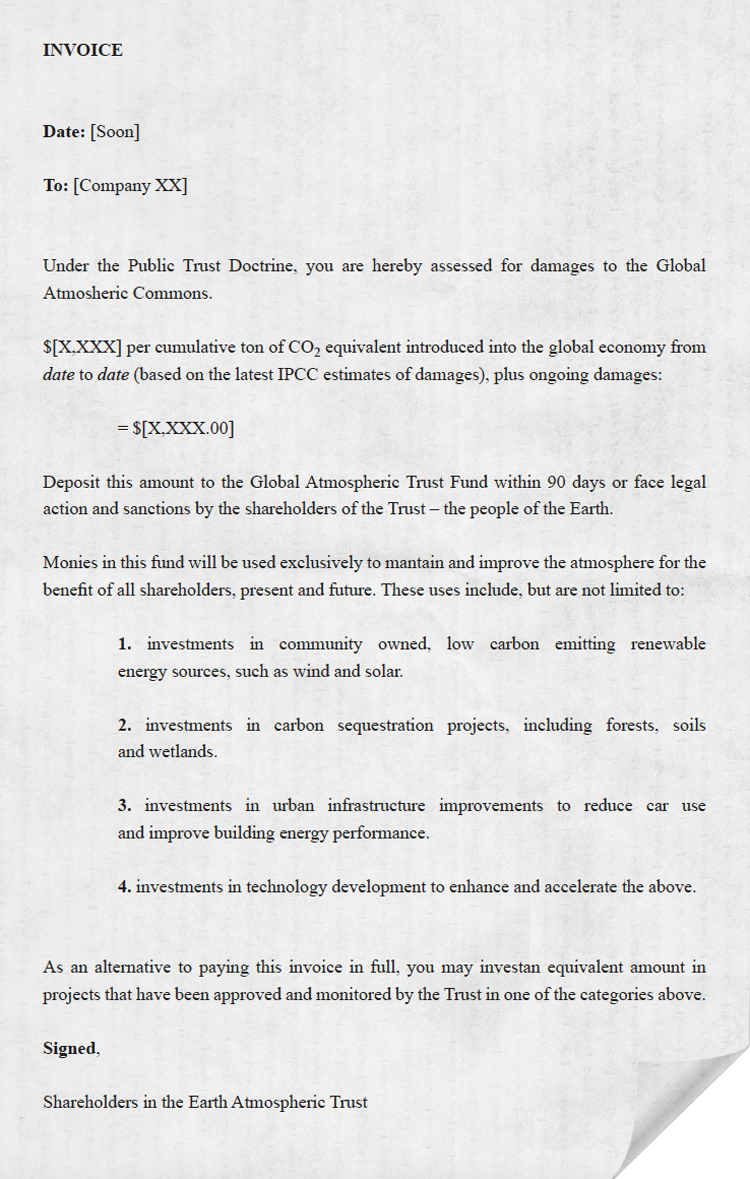The atmosphere is a community asset that belongs to all of us. The problem is that it is currently an open access resource – anyone can emit carbon dioxide into the atmosphere with no consequences to themselves – but with huge cumulative consequences to the climate and the global community. Many agree that charging companies and individuals for the damages their emissions cause, for example, a comprehensive carbon tax or cap/auction/dividend/trade system, would drastically cut emissions. However, despite some interesting regional experiments, implementing this kind of system via international negotiations at the global level has proven close to impossible. A few critical governments, influenced too much by fossil fuel interests, have been blocking binding commitments and effective economic instruments.
Global civil society can change this if it claims property rights over the atmosphere. By asserting that all of us collectively own the sky, we can begin to use the legal institutions surrounding property to protect our collective rights, charge for damages to the asset, and provide rewards for improving the asset. This idea has been proposed by Peter Barnes and others. The Public Trust Doctrine is a powerful emerging legal principle that supports this idea. In her book, Nature’s Trust: Environmental Law for a New Ecological Age, legal scholar Mary Wood describes how the Public Trust Doctrine has its roots in ancient Roman law and occurs in the many legal systems derived from it. The doctrine holds that certain natural resources are to be held in trust as assets to serve the public good. It is the government’s responsibility, as trustee, to protect these assets from harm and maintain them for the public’s use. Under this doctrine, the government cannot give away or sell off these public assets to private parties. The public trust doctrine has been used in many countries in the past to protect water bodies, shorelines, fresh water, wildlife, and other resources.
However, as Wood forcefully argues, the time has come to expand the purview of the doctrine to cover all of the critical natural capital and ecosystem services that support human well-being, including the atmosphere, the oceans, and biodiversity. She argues that governments have been shirking this responsibility to protect “nature’s trust” and need to be required to fulfill their duty, including claiming damages. This problem is complicated by the fact that the atmosphere is a global asset. However, from the perspective of Nature’s Trust, the fact that nations are co-trustees makes them no less responsible for protecting the asset than individual sovereigns are for protecting assets like shorelines or open water bodies that occur exclusively within their borders.
The Nature’s Trust idea significantly changes the whole discussion about how to deal with climate disruption. Rather than national governments negotiating with each other about emissions reductions, governments should see themselves as co-trustees with a fiduciary responsibility to protect the atmospheric trust. To do this, they can claim damages from the private interests that are causing the problem. As Wood notes, ‘Trustees have an affirmative obligation to recoup monetary damages against third parties that harm or destroy trust assets” (p. 185). If an oil spill occurs in the oceans, governments collect natural resource damages for cleaning up the mess. Yet they sit idle in the face of a catastrophic “spill” of carbon dioxide into the atmosphere.
Holding climate polluters accountable for their damage is more straightforward than it might seem. Approximately 90 companies globally are responsible for introducing two-thirds of the carbon emitted into the atmosphere. This means that damage claims could target a relatively small number of private interests. In addition, all governments would not need to agree in order to employ this tactic. Since all governments are co-trustees in the global atmospheric asset, a subset of nations could bring the damage claims. Damages achieved from these legal actions could fund restoration projects in those same countries, provided that they are certified to draw down atmospheric carbon or expedite the transition to non-nuclear, renewable energy. In addition, governments could charge for ongoing damages via a carbon tax or other mechanisms.
But, given that governments have not acted on their own, well planned civil-society pressure will be required to support governments to act, and to counteract the inevitable corporate resistance. A concerted effort to “claim the sky” as a public trust on behalf of all of global society, in combination with the solid legal framework provided by Wood’s work on the public trust doctrine, may just do the trick. The Civil Rights Movement in the US was based on equally solid legal principles, but required coordinated social activism to achieve success.
Let’s establish a broad coalition of individuals and groups and publicly declare on the web and in other venues that the atmosphere belongs to us and our descendants, and that we demand that the polluters pay for recovering and maintaining our atmosphere. Let’s establish an Earth Atmospheric Trust to charge for damages to the atmospheric commons and to qualify restoration projects (projects that achieve carbon drawdown through soil sequestration and reforestation, or that promote transition to a renewable energy infrastructure). These are not “carbon offset projects”. We have to go beyond offsets to demand cleanup of the atmosphere. The Trust can maintain a financial accounting and carbon accounting of projects funded by corporate polluters to carry out their liability to the citizen beneficiaries. A public outreach campaign to build pressure can start by sending invoices to the polluters themselves for past and ongoing damages. Imagine the following.
- An Earth Atmospheric Trust is established to collect past and ongoing damages and to certify and track restoration projects funded by corporations who are liable for carbon emissions, and to directly fund restoration projects.
- Groups of school children deliver invoices to the corporate headquarters of major fossil fuel companies with major media coverage (see box).
- 350.org and other groups take up the campaign to finally get movement toward their goal.
- The Occupy movement reinvigorates itself around this campaign.
- Major international NGOs, such as Conservation International, and the World Resources Institute, lend their support to the campaign.
- Major media personalities, like Robert Redford, Harrison Ford, Brad Pitt, Leonardo DiCaprio, Cameron Diaz, and others join the campaign.
- Michael Moore makes a documentary about the campaign.

Nature’s Trust has the potential to be a significant new legal and social force in the battle to bring human activities on the planet into compliance with “nature’s laws”. It is far past the time for the people of planet Earth to claim the future by claiming the sky.
42 Celebrities who care about the environment: www.examiner.com/article/42-celebrities-who-care-about-the-environment
Courtesy by Solutions Journal, www.thesolutionsjournal.com



